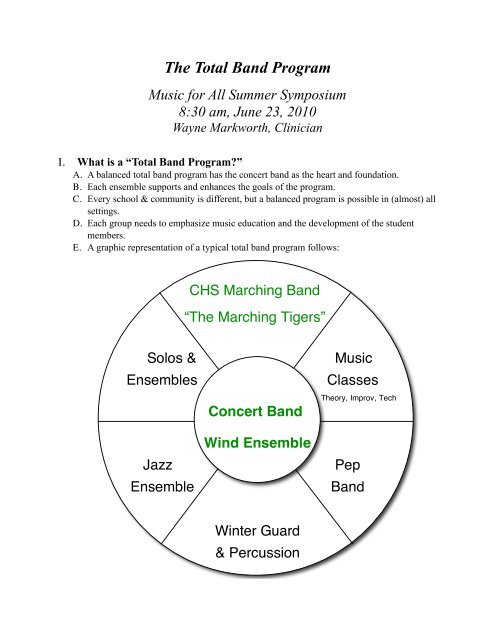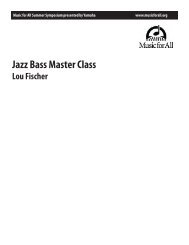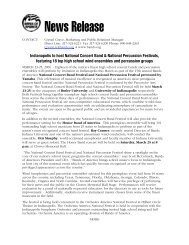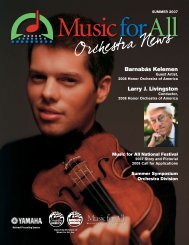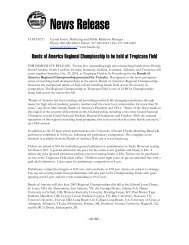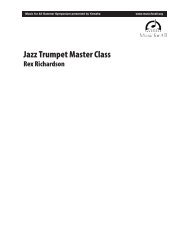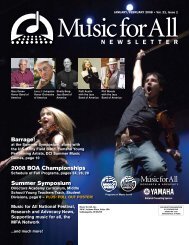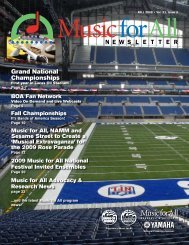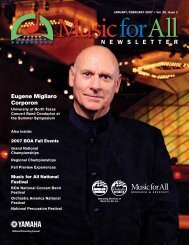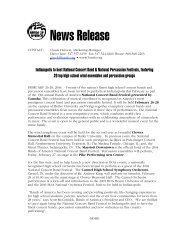The Total Band Program - Music for All
The Total Band Program - Music for All
The Total Band Program - Music for All
You also want an ePaper? Increase the reach of your titles
YUMPU automatically turns print PDFs into web optimized ePapers that Google loves.
<strong>The</strong> <strong>Total</strong> <strong>Band</strong> <strong>Program</strong><strong>Music</strong> <strong>for</strong> <strong>All</strong> Summer Symposium8:30 am, June 23, 2010Wayne Markworth, ClinicianCentral High SchoolI. What is a “<strong>Total</strong> <strong>Band</strong> <strong>Program</strong>?”A. A balanced total band program has the concert band as the heart and foundation.B. Each ensemble supports and enhances the goals of the program.<strong>Band</strong> <strong>Program</strong>C. Every school & community is different, but a balanced program is possible in (almost) allsettings.D. Each group needs to emphasize music education and the development of the studentmembers.E. A graphic representation of a typical total band program follows:CHS Marching <strong>Band</strong>“<strong>The</strong> Marching Tigers”Solos &EnsemblesJazzEnsembleConcert <strong>Band</strong>Wind Ensemble<strong>Music</strong>Classes<strong>The</strong>ory, Improv, TechPep<strong>Band</strong>Winter Guard& Percussion<strong>The</strong> concert ensembles – Concert <strong>Band</strong> and Wind Ensemble – are the foundation of the Central <strong>Band</strong>
II. <strong>The</strong> <strong>Total</strong> <strong>Band</strong> <strong>Program</strong> in the School & CommunityA. Communicate the <strong>Total</strong> <strong>Band</strong> philosophy frequently.B. VehiclesIII. <strong>The</strong> Elements of a <strong>Total</strong> <strong>Band</strong> <strong>Program</strong>IV. <strong>The</strong> “Secondary” ElementsA. Winter <strong>Program</strong>s Guard & DrumlineB. Solos & EnsemblesC. SolosD. Small EnsemblesE. Pep <strong>Band</strong>F. <strong>Music</strong> ClassesV. <strong>The</strong> Three Main ElementsA. <strong>The</strong> Concert <strong>Band</strong>B. <strong>The</strong> Jazz <strong>Program</strong>C. <strong>The</strong> Marching <strong>Band</strong>D. Commonalities1.2.3.4.5.6.7.VI. <strong>The</strong> Concert <strong>Band</strong>A. <strong>The</strong> heart & foundation of the total band programB. A typical rehearsal <strong>for</strong>mat
C. <strong>The</strong> fundamentals of music are the same in all styles of music.1. Sound2. Technique3. <strong>Music</strong>ianshipD. Daily Warm-up & Development - See Insert1.2.3.4.VII. <strong>The</strong> Marching <strong>Band</strong>A. <strong>The</strong> concert band is the heart and foundation of the <strong>Total</strong> <strong>Band</strong> <strong>Program</strong> BUT...B. <strong>The</strong> marching band starts each and every school year.C. <strong>The</strong> marching band sets the tone <strong>for</strong> the entire school year.D. In the eyes of most communities, administrators, school board members, and many bandparents, the Marching <strong>Band</strong> is the Generic High School <strong>Band</strong>!E. Parent Support <strong>for</strong> the <strong>Total</strong> <strong>Band</strong> <strong>Program</strong> is much easier to generate with the marchingband than the concert band.F. <strong>The</strong> opportunity <strong>for</strong> musical (and non-musical) development is tremendous because of theamount of time spent in most marching band situations.G. <strong>The</strong> key to this musical development is the Warm-up & Development segment at thebeginning of every rehearsal - See InsertH. A typical rehearsal <strong>for</strong>mat - Similar to Concert <strong>Band</strong>VIII.<strong>The</strong> Jazz <strong>Program</strong>A. A Jazz Ensemble is an important ingredient of the <strong>Total</strong> <strong>Band</strong> <strong>Program</strong>.B. <strong>The</strong> <strong>Band</strong> <strong>Program</strong> is not complete without it.C. If you are not com<strong>for</strong>table teaching jazz,learn and (or) get someone who is, to run the program.D. What is “Jazz?”
Trumpet1234& 4 4w w bwFw bwnww,,w w w w w,w # wnww w # w w w w w w , w w bww wb w bwnwbwnww w w& . .˙ ˙ ˙ ˙ ˙ ˙ ˙ ˙ ˙ ˙ ˙ ˙ ˙ w˙F56&&&œ-F œ -legatoœ œFbœetc. toœ- œ -œ - œ - œ - œ -’ ’ ’ ’œœ œ œœ bœœ œ œ œœ bœœœ- - - -œ œ œ œ ˙-œ - œ - œ - œ - ˙-œ œœœ ˙ , œ # œ œ œ œ œœ œ˙,,œ bœœ œ œ œ œ œ œ œ œ œ ˙œ œ œetc. to’ ’ ’ ’œ # œœwœ ˙,And back up’ ’ ’ ’& b . ˙ ˙ ˙ ˙ ˙ ˙ ˙ ˙ ˙ ˙ ˙U˙ ˙ ˙ . wF& b3 33 3 etc. toœ- œ - - œ œ- œ - œ - œ .œ-Fœ - - œ œ- œ - œ - ˙- œ- œ - œ - œ- œ - œ - ˙-œ . œ- œ - - œ œ- œ - œ - œ . œ’ ’ ’ ’. etc. to U’ ’ ’ ’ w3 33 37Interval tuning& b w nww bww w w bww w w w w#w nw w www n#FF f8& # . ˙ ˙ ˙ ˙ ˙ ˙ ˙ ˙ ˙ ˙ ˙ ˙ ˙ ˙ . w2 4f& # 2etc. toœ> œ . œ . œ . œ . œ . œ . œ> œ n 44>œ œ .œ . >œ œ .œ œ œ œ œ œ œ . œ . œ . œ . œ . œ . etc. to. > . . > . .’ ’’ ’ ˙f910Dynamics & Half-step tuning& n 4 w w w # w # w w w # w # w w. #4x's. . ## w w# w w .! p P F f p-P-F-f f_ƒ12U& w w w w w˙ ˙ ww w w w w ẇ ˙ 1st Divisi[ [[w w wPƒP Fƒ11Play 3x's-halves/quarters/eighthsPlay 3x's-halves/quarters/eighthsPlay 4x's-halves/quarters/eighths/sixteenthsDaily Warm-up© 2008 Shadow Lake <strong>Music</strong>Wayne Markworth2x'sb
Trumpet1Half-Steps & Lip Benders1& 4 #w w w w # w w w # w w w w w w # w w w # w w w # w w w w w bww bww bww w bww bwwF-236& # -œF œ-˙-Expanding Intervals in Fœ-œ-˙Daily Warm-up Two-œ-œ-˙-œ-œ-˙-œ-œ-˙-œœ--˙-œ-œ-˙Wayne Markworth-œœ--˙n44& n3>>œF œœ . œ . œœœ .œ .>œArticulation Study>œœ .œ . œ>>>œœ .œ œ .œ œ .œ . œœœ .œ œ .œ œ.œ ˙ ,.>- > œ # œœ . œ . œ>œœ . œ œ .># œœ . œ . œ>œœ . œ œ .># œœ . œ . œ>-œœ . œ œ . #œ œ ˙ ,œ . .52&>bœ>œœ . œ . bœ>œœ . œ bœ.>œœ . œ . bœ>œœ . œ bœ.>œœ . œ . bœ>- >œœ . œ bœ. œ b œœ ˙,œ..>œœ . œ . œ>œœ . œ œ .>œœ . œ . œ>œœ . œ œ .>œœ . œ . œ->œœ . œ œ . œ œ.œ ˙ ., And back up#’’’’61& #4Uœ œ œ œ w ,fUœ œ œ œ w ,œ œ œ œ œU ,,˙.œ œ œ œ œ œ ˙Uœ œ œ œ œ œ œ œ w U ,72& #œ œ œ œUw,U ,œ œ œ œ wUœ œ œ œ œ ˙.,U ,œ œ œ œ œœ œœ˙œ œ œ œ œ œU ,wn583& nLip Slursœ œ œ œ œ œ œ œfœ œ œ œ œ œ œ œ œ œ œ œ œ œ œ œ ˙.J œ ‰ œ # œ œ œ œ # œ œ œ œ # œ œ œ œ # œ œ œ œ # œ œ œ œ # œ œ œ ˙ .J œ ‰91&bœœ œ œ œ œœœ bœœ œ œ œ œœœ bœœ œ œ œ œœœ b˙.J œ ‰ œ œ œ œ œ # œ œ œ œ œ œ œ œ # œ œ œ œ œ œ œ œ # œ œ œ ˙.jœ ‰ ’’’’#And back up© 2007 Shadow Lake <strong>Music</strong>
ARTICULATION SYLLABLESFOR ALL ENSEMBLESArticulation Symbol *Syllable LengthLegato - DOO FullStaccato . DOO !Accent > TOO "Marcato ^ TOO !Long accent > TOO or DOO FullRemember:AirflowOnly use “TOO” or “DOO”(*Saxophones “TOO” or “THOO”)


